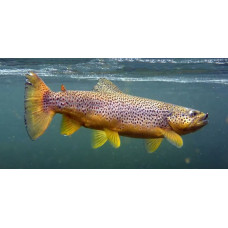Brown trout (Salmo trutta) is a passerine fish of the noble salmon genus. It has numerous spots, often v-shaped all over the body. It is distributed along the European coast of the Atlantic Ocean, entering rivers from the Pechora in the north to the Iberian Peninsula in the south. In the basins of the Black, Caspian and Aral seas it is represented by subspecies. It forms intraspecific forms differing in appearance, coloration and lifestyle. Salmo trutta is the original form of freshwater river or brook trout living in the upper reaches of rivers. Subspecies are the Black Sea Brown trout (Salmo trutta labrax) and the Caspian salmon (Salmo caspius). Sexual maturity occurs in the fifth to sixth year of life. Spawns in the fall, September-November, burying eggs in nests on sandy-pebble soil. Fecundity is 4.7-23.0 thousand eggs. Juveniles spend from 1 to 7 years in the river. Salmo trutta feeds on large crustaceans and fish. Valuable commercial fish. Lake or brook - live forms of this salmon are called trout.
The usual size of adult kumzhi varies by subspecies - up to 30-70 cm in length and 1-5 kg in weight, with some subspecies reaching a weight of 24 kg and a length of up to 117 cm.
The passage, lake and stream forms easily change into each other - they are very ecologically plastic fish; for example, the stream form transported to New Zealand rolled into the sea and became the passage kumja.
The passable form of kumzhy enters the rivers of Europe from the Iberian Peninsula in the south to the Pechora River in the north. It is also found in the White, Baltic, Black and Aral Seas. The brook form is widespread, occurring in mountain streams of Morocco, Algeria, Tunisia, Spain, Portugal, France, Corsica, Sardinia, Sicily, Italy, Greece, Asia Minor, and in the upper reaches of the Euphrates and Amu Darya. In America, the koumzha is acclimatized by man.
In many rivers, fish go practically all year round, although there are peaks of spring, summer or fall runs. One female hatches about 3-4 thousand eggs, which after fertilization buries in the ground. The eggs are rather large, up to 5 mm. Spawning kumzha continue to feed, although less intensively, and after spawning the migratory forms return to the sea for a rest. The young fish are very similar to piscivorous salmon and spend from 3 to 7 years in fresh water. In the sea, kumzha live from one to four years. It feeds on herring, smelt, stickleback, sand lance and various invertebrates. Valuable commercial fish. The stream and lake forms, as well as the passage kumzha, are artificially bred. With abundant feeding, it is possible to obtain 50 centners and more per hectare of pond annually.
Brown trout
Tags: brown trout




